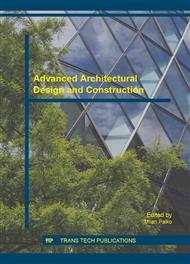p.351
p.359
p.365
p.371
p.379
p.385
p.391
p.396
p.402
Determination of Fire Resistance of Ceiling Structure Variant Design on the Basis of Timber Using Numerical Calculation Methods
Abstract:
Ability to resist of high temperature impacts during fire is not based exclusively on ignitability of building materials. At the present time, fire resistance is declared mainly through fire tests, but numerical procedures for the determination of fire resistance also represent an effective alternative in this field. Using calculation methods for the determination of ceiling structure fire resistance on the basis of timber is subject of the submitted paper. The main objective of this paper is to demonstrate the fact that timber, or products from it, are building materials capable to resist impacts of fully developed fire for the period of more than 60 minutes in spite of their flammability. Applicability of these results in selected countries of Europe can be seen from the list of requirements.
Info:
Periodical:
Pages:
379-384
Citation:
Online since:
January 2016
Authors:
Keywords:
Price:
Сopyright:
© 2016 Trans Tech Publications Ltd. All Rights Reserved
Share:
Citation:


